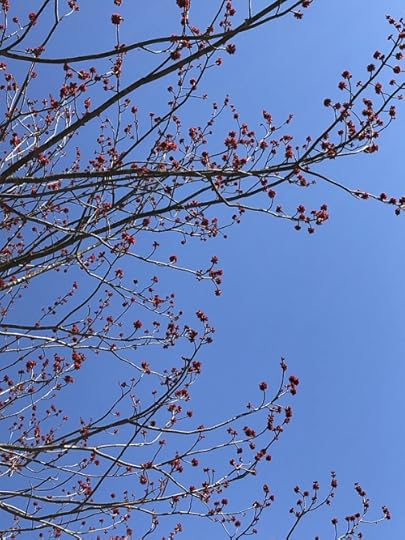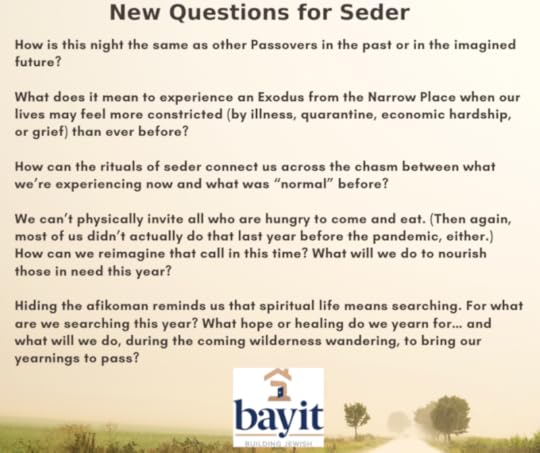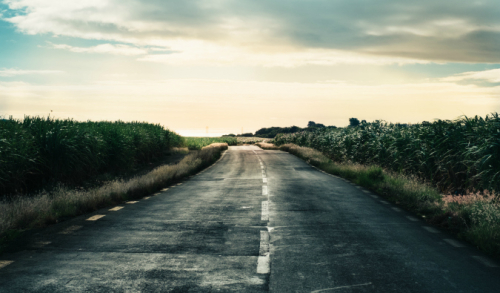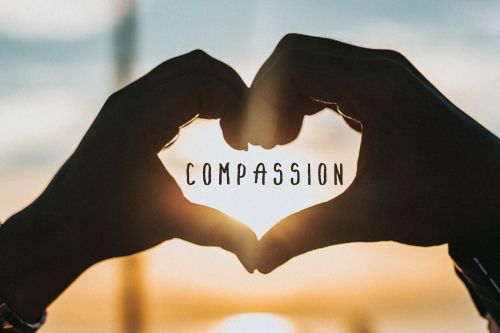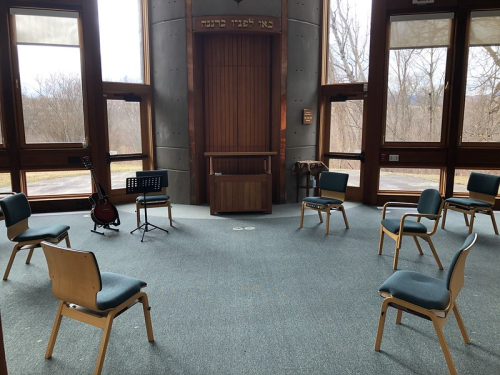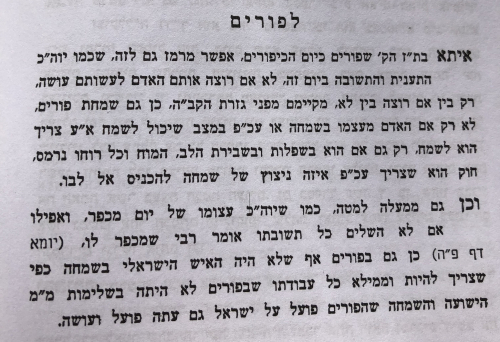Rachel Barenblat's Blog, page 48
April 11, 2020
A part
Furled tufts of red pop
at the tip of every maple branch
bright against a clouded sky.
I know there's blue
stretching above that white ceiling
even when I can't see it,
I know beyond our thin atmosphere
we're cradled in the vastness of space.
Even when I feel stuck in my skin
in the seclusion of social distancing
cloaked in mask and gloves
unable to touch
the maple and I are breathing together
(you and I are breathing together)
even when I feel apart.

April 10, 2020
Four weeks in
The tree outside my front door, on a blue-sky day earlier this week.
It's been four weeks since life stopped feeling normal. On good-weather days, I leave the house to take walks with my kid. Every so often I leave the house to replenish groceries (wearing a cloth mask and gloves). Otherwise we're home. We see friends via Zoom, which is better than nothing but still frustratingly intangible, especially for my kid. This new normal is not normal.
My kid is grappling with big questions. The other night he asked me why, if God heard the cries of the children of Israel in Mitzrayim and freed us from slavery (e.g. the Exodus), why isn't God freeing us from the pandemic? That sparked a big conversation about what it might mean if God doesn't reach into the world to "fix" things, even if we really want God to.
We talked about how we can find God's presence in the helpers, in the people working toward a vaccine, in acts of kindness. We talked about the idea that God accompanies us and feels our fears with us. And I thought: this is a heck of a way for him to begin to move beyond the little-kid theology that imagines that God will fix everything if we just ask hard enough.
I read the news every day and my heart aches. So many deaths, so much suffering -- it's almost more than I can process. And then I set the news aside and I teach an online class for my synagogue, or I sit with my kid to work on a social studies worksheet, and I am grateful both for my work and for the ways in which homeschooling requires me to focus on what's in front of me.
And even in the midst of this unthinkable tragedy and trauma, there are moments of connection. I led a shiva minyan on Zoom the other day for a friend who had lost a family member (not to covid19.) The screen filled up with friends and family, people from all parts of her life, people of many religious traditions, people in many time zones -- including one in Australia.
And I thought: before the pandemic, most of us wouldn't have held a Zoom shiva minyan so that friends in far-flung places could take part. I still wish we could have gathered in person to comfort this mourner. I hold tight to the faith that someday we will be able to gather in person again, and hug each other. I ache for that. And... I'm grateful for what connection is possible.
Lately I've been gazing at the big tree in front of my condo. Its twigs have sprouted little red tufts. Soon they will unfurl into leaves. I take comfort in that. Spring will come and we don't have to do anything to make it come, or to make its beauty exist. We don't know how long the pandemic will last, or when we will be able to touch each other again, but the seasons remain.

April 3, 2020
New questions
March 30, 2020
We are exactly where the Pesach story calls us to be
This is going to be a Passover unlike any other. I wrote a long paragraph of reasons why that is so, and then I deleted them. You are living in this world too. You don't need me to tell you any of the reasons why this year is different from any other year that any of us have ever lived through. You don't need me to tell you what's strange or scary or overwhelming or unknown, or why it feels so weird to be approaching Pesach in this moment when life feels both empty (of normalcy) and over-full (of fear).
The story of the Exodus, the story we re-tell each year during the seder, is the story of how our spiritual ancestors left Mitzrayim, "The Narrow Place." The Pesach story -- our national story as a people -- begins in tight constriction. It begins in dire straits. It begins in a time and place of profound inequality, when there was an unthinkable gap between rich (Pharaoh) and poor (the ancient Israelite slaves). It begins with plagues, darkness, sickness, death, and leaving behind everything that was familiar.
The tradition says each of us is to see ourselves as though we ourselves had been brought out of Mitzrayim. I don't know about you, but the idea that we are living in Mitzrayim -- the Narrow Place; tight constriction; dire straits -- feels very real to me this year. If we are feeling constricted, anxious, afraid, uncertain, maybe newly-aware of some of our society's fundamental inequalities and the harm they cause to the most vulnerable... then we are exactly where the Pesach story calls us to be.
When we left that Narrow Place, we didn't know where we were going. We didn't have time to fully prepare for our journey of transformation. We didn't know where we were going or how we would get there. We left the Narrow Place anyway, because it had become clear that staying where we were -- staying with the status quo -- meant death. If we are feeling unready, unprepared, maybe thrust into a journey we don't know how to take... then we are exactly where the Pesach story calls us to be.
In Talmud (Pesachim 116a) we read that מתחיל בגנות ומסיים בשבח - one should begin the recounting of the Exodus story with degradation, and one should end with praise. That's the spiritual journey encapsulated and recapitulated in the seder. The haggadah moves from the degradation of "we were slaves to a Pharaoh in Egypt" to the praise songs of Hallel on the far side of the sea. The haggadah takes us from despair to redemption, from constriction to freedom, from mourning to dancing.
Right now we are at the beginning of the story of the covid-19 pandemic of 2020. We begin in "degradation" -- in this Narrow Place, in this fearful place, in this grief-stricken place. Our task is to trust that this is only where our story begins, not where it will end. Our work is to stay home, help those whom we can help, and cultivate our ability to hope. May scientists' labors toward a vaccine bear fruit, so that someday this slow-motion global tragedy will end and we will dance on the far shores of the sea.
If you're looking for resources for a home-based seder this year, here's a post I wrote for Builders Blog: Resources for Seder in a Time of Quarantine.

March 25, 2020
Crying out and compassion
As this week began I studied a text from the Piaceczyner, aka the Aish Kodesh, aka R' Kalman Kalonymus Shapiro, the rabbi of the Warsaw Ghetto. He teaches that as human beings, when we feel one another's pain -- when our hearts break for each others' suffering -- when one of our fellow human beings calls out, and we listen with open heart -- we empower the angels on high. .
Calling out to each other is part of how we share each others' burdens. And the Piaceczyner cites an old Aramaic translation to connect calling with receiving. It's connective, relational. This becomes a metaphor not only for how we imagine the angels interacting with each other, but even how we imagine God interacting with us. We call out to God, and God calls out to us.
That's how this week's Torah portion begins: with God calling out to Moshe. The Piaceczyner draws on midrash to say that God is like a human being who cries out to a friend, "help me carry this burden?" The burden that God wants help in carrying is our human suffering, which God feels-with-us. Even God takes comfort, when bearing a burden, in not having to carry it alone.
When we're in relationship with each other, when we call out to each other, when we feel-with one another and seek to lessen one another's pain, that's a gift we give each other. And because we're in relationship with God, when we cry out to God and God cries out to us, we are (as it were) giving that gift to God, and God is giving it to us in turn. What an amazing idea that is.
This is a time of immense suffering in the parts of the world where the pandemic has already crested. Here where I live, we are braced for what seems to be the near-certainty of immense suffering here too. There aren't enough ventilators for those who will need them, and there isn't enough protective gear to protect the doctors and nurses who risk life in caring for the sick.
As human beings, we have the choice of feeling each others' pain, or numbing ourselves to each others' pain. We can exercise compassion -- literally feeling-with-another -- or we can turn away. There are those who shrug and say that deaths are inevitable and shouldn't halt the economy. To me, that response is barbaric and inhumane. I think the Piaceczyner would agree.
The Piaceczyner was writing from the Warsaw Ghetto. The Jewish community to which he ministered there was in profound crisis, and things were about to get much worse. His response to that was: compassion. We must feel-with each other, cry out to each other and to God, carry each other's burdens... as God cries out to us, carries our burdens with us, feels with us.
When we cry out and also receive the cries of others, we strengthen our compassion. I learned a different text from the Piaceczyner recently about faith. Faith is the soul's way of knowing and seeing. Faith is like the heart, beating even if we're not conscious of it -- and we also need to exercise it. I think the same is true of compassion: we need to choose to use it, often.
Cry out! Because if we numb ourselves to grief, we also numb ourselves to joy. Because crying-out is relational, and in the connection between crier and listener there is holiness. And open your heart to the cries of others who are suffering or afraid. Because hearing each other in this time is how we exercise compassion, like the One in Whose image all are made.
With gratitude to R' Megan Doherty, and to my hevre at Bayit: Building Jewish, with whom I studied this text this week.
The primary text I'm drawing on here is the Aish Kodesh on Vayikra 5700 / 1940. The second text, the one about faith, is his writing on Parshat Ha-Chodesh 5702/ 1942. Deep thanks to R' David Markus for learning that text with me.

March 21, 2020
The new normal
My synagogue, set up for precisely a minyan, with social distancing.
Yesterday was my forty-fifth birthday. I began it doing a few of the things I love most: leading others in prayer and song, and welcoming a new adult into the Jewish community. That's been the plan for March 21 for more than a year now. Of course, it didn't quite happen the way we had been envisioning it.
That was the last service that will be held in our sanctuary for some time. Attendance in person was limited to a minyan, who had to sit six feet apart. When we called up grandparents for an aliyah, we carried an iPad up to the amud (Torah reading table) because grandparents were attending digitally
From now on, our Shabbat morning services will be offered via zoom. We'll daven together from places that are apart. I don't know what we'll do about upcoming celebrations of b-mitzvah. There are so many things that I don't know, and can't know -- none of us can. Welcome to rabbi-ing in a time of pandemic.
I'm slowly settling in to the rhythm of this new normal. Much of last week was dedicated to figuring out what it will look like to homeschool my kid. He's out of school for three weeks (as of now), but I'm bracing for schools to be closed until next fall, as is already the case in several other states.
We set up our school space at the dining room table, and I worked on synagogue things -- reaching out to congregants, researching whether our chevra kadisha can safely do taharah during a pandemic -- during the quiet moments while my kid was doing social studies or reading a book or solving math problems.
At night I shifted gears between comforting my kid (not surprisingly, he's been wrestling with "difficult thoughts" and anxiety -- who among us isn't?) and offering pastoral care via all the distance modalities I know. I anticipate a lot more of both of those in the weeks (and probably months) to come.
I wrote to my synagogue community Friday that even though we are apart in physical space, we are together in heart and spirit. And we are only at the beginning of the journey through the valley of covid-19. We will all need to learn ways to feel, and to strengthen, those connections of heart and spirit.
I don't know how to end this post. My literary training suggests that this post needs to go somewhere, but I don't know where anything is going right now. I trust that we will eventually make it to the far side of this pandemic -- we who survive. I hope that I am among the survivors; I hope that you are too.
But I don't know what after will look like, or whether this will be only the first pandemic of many in this strange new world, or how my parenting (everyone's parenting) will have to shift in response to pandemic and a possible new Great Depression, or how my Judaism (everyone's Judaism) will have to shift too.
I did my best to have a Shabbes. I'm doing all the things I know how (in isolation) to connect my heart and spirit with others, with my traditions, with my Source. (I even baked myself a birthday cake.) I know that the new week will ask a lot. In Robert Frost's words, "there's no way out but through."

March 13, 2020
Like a fiddler on the roof
This is the message I sent to my synagogue community today. I thought it might speak to some of y'all too. Shabbat shalom to all who celebrate.
Not long ago I was preparing to take my son to see the national touring production of Fiddler on the Roof, in which my niece Noa Luz Barenblat plays Chava. My son asked me, “what does the title of the play mean?” I told him here’s how I understand it: Life is precarious, but we still need music. We still need art and beauty and melody. We still need our traditions and what connects us with each other and our generations and our Source. Even when we feel that life is as precarious as a fiddler balanced on a rooftop. Maybe especially then.
The fiddler on the roof in Anatevka represents the miracle of the human spirit: singing out sometimes in pain and sometimes in joy, making music and marking holy time, even when life feels precarious. I find a deep teaching about spiritual resilience there — especially now.
For many of us, the covid-19 pandemic is awakening a sense of precariousness. None of us knows what tomorrow will bring. Of course, that’s always true, pandemic or not… but most of us don’t live with constant awareness of the fragility of our lives and the lives of those whom we love. How can we best navigate this time?
I have two answers: take care of ourselves, and take care of each other. And I think we can learn something about how to do that from the Jews of Anatevka.
The Jews of Anatevka were materially poor, but they were rich in community and traditions. We too have community — even when circumstances obligate us to connect via phone or zoom instead of in person. We too have traditions — even when circumstances obligate us to celebrate those traditions in slightly different ways for a while. Music and prayer can still uplift us, even if we’re feeling anxious and uncertain — or maybe especially then.
My friend and colleague Rabbi Danya Ruttenberg writes that now is a great time to double down on our spiritual practices… and if we don’t think we have any, now is a good time to develop some! Whether that means prayer, meditation, yoga, making art, listening to music: we should lean into whatever sustains our hearts and souls in this time. Because we’re going to need every ounce of strength and compassion and rootedness we’ve got in order to take care of each other.
One of the ways we’re taking care of each other is by pulling back from physical contact. The temporary closing of colleges and theatres and houses of worship is a step that’s being taken in order to protect the whole of our interconnected community. The hope is that these closures will slow the spread of the virus so that our hospital can keep up with the pace of infection. What higher aspiration could a community seek than to care for each other in these ways?
And, there are other ways that we can take care of each other, even at a distance. Even when we have to close down services for a while, we can gather via zoom. And we can call and email and text and Facetime and Skype and zoom with each other. It’s not the same as being together in person as a community — and, it’s still real human connection that can uplift our hearts.
Please do check up on each other. Reach out in all the modalities that the modern world offers. Take care of each other… and take care of you, too.
May our connections with each other, and with our traditions, and with our Source, sustain us through the pandemic and beyond.

March 10, 2020
The tiniest spark of joy
We read in the Tikkunei Zohar that Purim is like Yom Kippur. This is hinted-at in the way that on Yom Kippur, one must fast and do teshuvah (repentance / return) not only if one feels like it, but whether or not one wants to do it. This is an enduring decree from the Holy One of Blessing. Rejoicing on Purim is similar. One is obligated to rejoice on Purim, not only if one is happy in oneself, or is in a situation where it's easy to feel joy. On the contrary: even if one is in a low place and completely broken-hearted, body and spirit laid low, it's still an obligation to seek out whatever tiny spark of joy is possible, and welcome that spark into the heart.
On both of these holy days, there's a flow from on high to us here below. Just as Yom Kippur itself atones for us, even if our teshuvah feels inadequate (according to Talmud in tractate Yoma), just so on Purim. Even if a person isn't feeling joyful the way one's supposed to, and therefore one's service of God doesn't feel whole, even in that case the salvation and joy of Purim will flow -- and that potential is open to us even now.
-- The Piazeczyner aka The Aish Kodesh aka R' Kalonymos Kalmish Shapira, Purim 1940
Last year, Purim happened a scant few weeks after my mother's death. I was shellshocked. I was in a fog. I scarcely remember the holiday at all. But I remember taking comfort in a text that R' David Markus taught me over the phone. The text said that Purim itself would do its work in me and on me, as Yom Kippur does, and that even if I couldn't access real joy, there would still be a flow from on high that would come through me to those whom I serve.
This year I sat down twice to study this short text from the Aish Kodesh, once with my Bayit hevre, and once with my other hevruta R' Megan Doherty. And only today, on Purim itself, did I realize why this text resonates with me so deeply and why it feels so familiar: this is the teaching R' David shared with me last year when I was in the pit of grief. And, in fact, it turns out this is a teaching I had shared with him a few years prior and had forgotten!
What jumps out at me in this text this year is the idea that we are obligated to welcome into our hearts whatever tiny spark of joy we can find. This isn't spiritual bypassing. This isn't "put on a happy face." This is the spiritual practice of opening our hearts even in difficult circumstances, so that some measure of blessing can flow in. The Aish Kodesh was writing from the Warsaw Ghetto; he knew something about difficult circumstances.
God would like us to be joyful
Even when our hearts lie panting on the floor.
How much more can we be joyful
When there's really something
To be joyful for?
-- To Life, To Life, L'Chayim / Fiddler on the Roof
I thought of this teaching a few days ago when I was blessed to see the national touring production of Fiddler on the Roof. "God would like us to be joyful / even when our hearts lie panting on the floor" -- Tevye might have been citing the Piazeczyner! Even when our hearts lie panting on the floor, Purim invites us to open our broken hearts to a spark of joy. Even when our circumstances (individual or collective) are dark, our tradition invites us to open to joy.
And when there is within reach "something to be joyful for," in Fiddler's words -- maybe a birth, or a wedding, a friendship, a sign of hope, a Shabbes -- we've got to seize that joy with both hands. Because joy is part of what fuels us. Because without joy, we can't go on. And the world needs us to go on, because there's a lot of work we need to do to bring justice and hope and ethics and opportunity and peace to everyone everywhere, and that's what we're here for.
So if today we're in the narrow straits of a personal grief, a loss or an illness or a sorrow... or if we're in the narrow straits of communal anxiety about the election, or the economy, or the pandemic that is sweeping the globe... we shouldn't kick ourselves for not being able to fulfill the mitzvah of rejoicing. Instead, let's open our hearts the tiniest crack, and let the tiniest spark of joy and hope come in -- and trust that the day itself will do the rest.

March 7, 2020
Engraved on our hearts
One artist's rendering of the stones for Aaron's shoulders, engraved with the names of the 12 tribes.
In this week's Torah portion we read about the instructions for making special garments for Aaron, brother of Moses: the first High Priest. We read about blue, purple, and crimson thread; about exquisitely decorated vestments; and about Aaron being declared "Holy to God." What leapt out at me this year are the two precious stones engraved with the names of all the tribes of Israel. (Ex. 28:9-12) Aaron carried the names of the whole community on his shoulders, or at least, the names of the twelve tribes that together represented the whole community. Because to serve the community means to serve the whole community.
Today we welcome a beautiful little girl into our community. And I can't wait to find out who she'll grow up to be. Maybe she'll want to put on costumes and star in our Purim play. Maybe she'll sing the Four Questions at the community seder. Maybe she'll make friends in our Hebrew school. And yet she isn't just joining this little rural shul, this smalltown community. Because we're part of something much bigger. We're connected with Jews around the world, on every continent. And we're connected with our spiritual ancestors stretching back thousands of years, and hopefully stretching forward at least as long.
To serve the community means to serve the whole community -- and to join the community means to join the whole community. I point this out over and over to those who join the Jewish people as adults: they're not just joining this shul, they're joining the entire Jewish people! They're joining Jews of every denomination, Jews of every race and skin color, Jews of every sexual orientation and gender expression. Rationalists and mystics, theists and atheists. Jews who express their Jewishness in so many different ways: through prayer, or poetry, or study, or feeding the hungry, or working for justice, or so much more.
There hasn't been a High Priest in thousands of years. But as I sat with this Torah portion this week, here's what came to me: what if all of us together could make the choice to engrave the names of the whole community -- not on our shoulders, but on our hearts? Those names now include the name of the newest member of our community, to whom we are now responsible. It takes a village to raise a kid, and our shul is now part of her village. May we engrave her name, and each others' names, on our hearts. And in that way, may all of us together be "holy to God," as Aaron was, so very long ago. Shabbat shalom.
This is the d'varling I offered at Shabbat morning services (cross-posted to my congregational From the Rabbi blog.)

March 5, 2020
Sketchnoting for b-mitzvah students - at Builders Blog
The first time Steve Silbert sketchnoted one of my divrei Torah, I was enthralled. The things he chose to highlight showed me what he found interesting in what I had written. His images uplifted my ideas in a new way. His sketchnote, rooted in my d’var Torah, was also its own piece of Torah creativity. That first sketchnote was my introduction to the spiritual technology of Visual Torah, now one of the tools Bayit offers for building Jewish life and practice.
In 2019 Steve came to Bayit’s rabbinic innovation retreat to teach the art and spiritual practice of Jewish sketchnoting to a denominationally diverse group of rabbis, most of whom insisted that we couldn’t draw. Steve taught us that sketchnoting is about ideas, not art, and that anyone can do it: even us. By the end of that session, all of us had taken a crack at sketchnoting… and I had a vision of using sketchnoting to uplift my Hebrew school teaching. This year, I invited Steve to join my b-mitzvah class remotely, to teach the basics of sketchnoting to my students...
That's the beginning of my latest post for Bayit's Builders Blog -- about bringing Steve Silbert, sketchnoting, and the spiritual technology of Visual Torah into my b-mitzvah classroom. I'm excited to be able to share this write-up of this innovation -- what we did, how we did it, whether it worked, and how we know whether it worked! Read the whole post at Builders Blog.

Rachel Barenblat's Blog
- Rachel Barenblat's profile
- 6 followers


